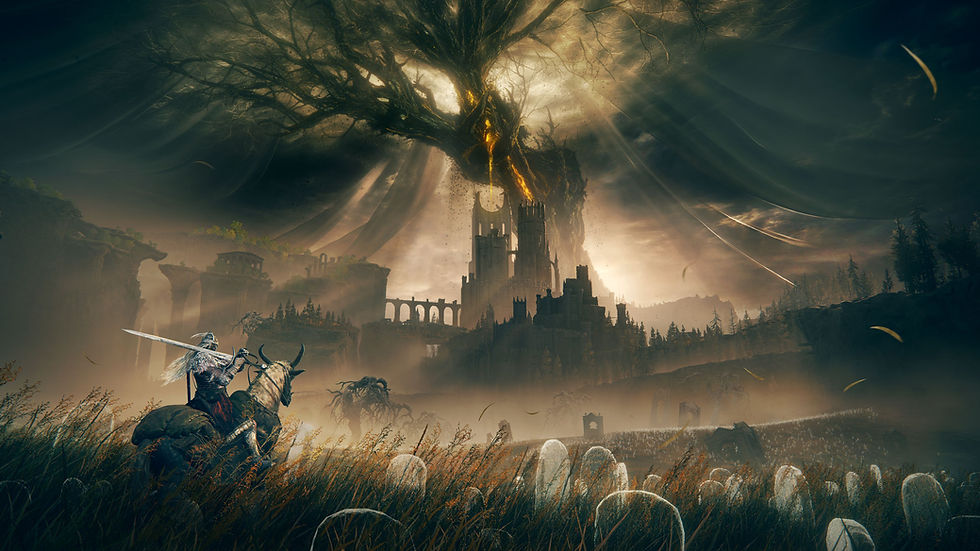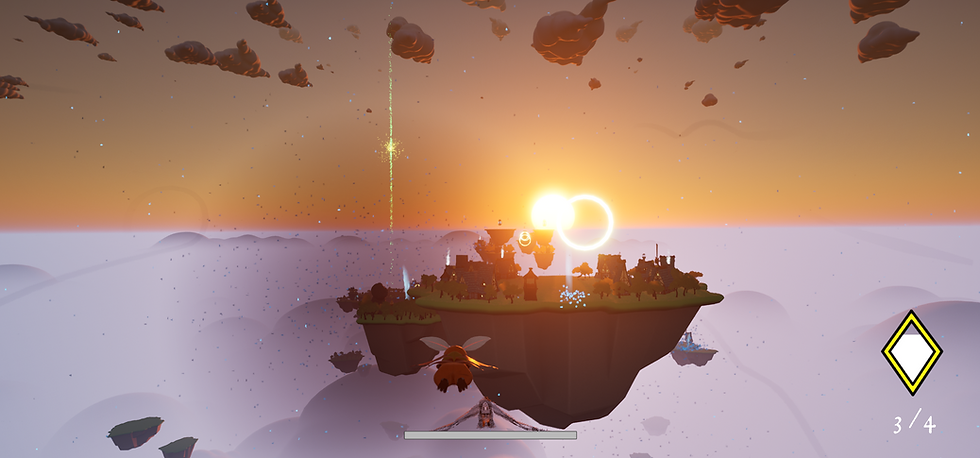Ash: A Development and Design Overview
- rscpalmer02
- Jul 23, 2024
- 7 min read
Building on Emotion
I believe that one of the purest reflections of a game’s quality lies in its ability to evoke an emotional response in players. Of course, this isn’t the only metric to measure a game’s success, but the range and depth of a game’s emotional impact is an often diverse indicator of a player’s experience. This is because video games are a uniquely and inherently emotional medium, due to the core placement of interaction and agency.
The unavoidability of emotion in games leads to a myriad of unique experiences ranging from inspiring or uplifting to boring or infuriating. So whether it's the boiling frustration of Elden Ring, or the lingering melancholy left by The Last of Us: Part Two, it has been consistently shown that games have an undeniable potential for delivering emotional experiences. With this in mind, the benefits of designing a game around a specific emotional experience become abundantly clear. By focusing on a specific emotional goal from the earliest moments of development, creators can ensure every aspect of their game works together in building a consistent and engaging product.


This was the thinking shared by a small team of classmates and I when we started production on our four-month game project, Ash. By using elements selected from Plutchik’s Wheel of Emotions as guidelines during early design discussions, our decisions would be able to consistently support at least one aspect of a layered emotional goal. Our initial talks resulted in the plan to create a meditative game built around the core mechanic of gliding, as players explore diverse environments and uncover a buried history. The game would use serenity, anticipation, and amazement as prompts, with the following definitions of how they would be applied.

Serenity: At its most fundamental level, the game is meant to be a relaxing experience free of frustration or difficulty.
Anticipation: Players should be able to explore and discover environments however they wish, without feeling lost or like they aren’t making progress.
Amazement: Beautiful and diverse environments, soothing music, and eye-catching artwork should be intrinsic rewards for players.
Initial Development and Movement Prototypes
With our goals established and a primary mechanic in mind, we began working on some initial tasks to kick off development. Each team member was given a distinct role, responsible for a specific aspect of the game, based on individual skills and desired workload. As I could offer more time to the project than others, I took on the roles of producer and lead designer, meaning my tasks ranged from ensuring consistent progress and delegating tasks, to leading the development of mechanics and level implementation. After setting up a Jira project including a timeline and task board, I began working on some movement prototypes in Unreal Engine. We wanted to create a gliding system that would feel fluid, effortless, and satisfying, with various abilities to control the player’s movement as they soar through the air. To stay in line with our emotional goals, we needed to ensure gliding remained carefree and simple enough so a large portion of a player’s focus could remain on exploring and appreciating the environments themselves.

The first step here would be to create the gliding itself, which I did with a simple toggle that would reduce the force of gravity, increase max speed/acceleration, and decrease friction. This simple ability would allow players to coast from one point to another at a far greater pace than they would by walking, but this system was still far from completion. In isolation, the ability was boring, lacked general usability, and would require further inputs to round out the system. Unfortunately, given the fact that players would still constantly be descending, the ability could only function properly from an elevated point.

To ensure gliding was always available and not locked by terrain, I greatly increased the character’s jump height at the cost of a few seconds of holding down the input. Not only did this ensure the gliding system was consistently available, but also created a sense of anticipation as players prepared to launch into flight.

Next, in order to prevent gliding from feeling like a static or un-interactive system, we created an option to prolong their time in the air. The “dive” input was our first solution to this: where the character rapidly accelerates downwards before receiving a vertical boost based on their total height lost. While this ability had the desired gameplay effect, we would later come to realize it took away from the system’s fluidity, an issue that would be remedied later in development.

The final prototype, labeled as a “dash” by the team, would be another option for players to gain speed and height. This versatile input would cause the character to gain a burst of forward velocity, but when interrupted by an obstacle, the character would begin to quickly climb and eventually launch off the surface. In later testing, the vertical aspect of the input proved to be confusing to new players but the option was generally successful. While these abilities weren’t particularly complex and would later be altered, they offered a meaningful starting point and excellent proof of concept for our vision of the game’s movement system.
Level Design Snapshot

Of course, the quality of our movement system would be irrelevant without environments for players to navigate. Three members of our group, myself included, continuously worked on small levels with distinct aesthetics and features. My level would serve as the game’s final section after players receive the relatively complex “dash” ability: a suitable reward for completing the previous sections and a key consideration for designing the map. With these factors in mind, I decided to create a desert-themed environment that would contain flowing sand dunes, jarring plateaus, and buried ruins. I began the process by drawing an outline on paper, creating a layout that would gently guide players to their destination while providing a series of scattered landmarks at various elevations. To decide on the environment’s natural and cultural landmarks, I researched common features and beliefs found in desert communities to ensure that the level’s stylized and fantastical qualities were supported by realistic traits.

During this whole level conceptualization period, one of my greatest supports was Christopher Alexander’s book on architectural design entitled “A Pattern Language”. The book outlines a series of architectural patterns that should be compiled in the creation of a “language” for your design to follow. Despite it not being written for use within games, I have found this resource to be invaluable, ensuring my level adhered to design principles that would improve pacing, visuals, and the general feel. With my resources gathered and concepts in place, I could begin experimenting within Unreal Engine, creating a quick landscape visualizing the shape of the area. While many other changes would still be made to the level over the following months, the countless number of decisions is far too great to examine here, and I believe time would be better spent refocusing this post to larger design changes.

Playtesting and Reevaluating
The largest period of major changes came about in direct response to our first playtesting session, giving us an abundance of valuable feedback and new ideas on how to improve the game. One of the most difficult parts of sharing any personal work is receiving feedback that, while not necessarily negative, conflicts with your understanding of the work. While it’s easy to see this kind of feedback as a harmful reflection of your failure as a creator, we strove to listen carefully and incorporate any feedback in future versions of the game. One of the most common responses we received pertained to the movement system, indicating that the current movement options were unhelpful and unsatisfying. To remedy this, we needed to create more fluid movements while gliding; giving players full control over their motions without it feeling overly complicated.
Drawing inspiration from the movements of wingsuits, I tweaked the gliding inputs so players could gradually and incrementally pitch the character downward, upward, left, or right, and gain velocity for that direction. While each input could now directly control motion, the downwards and upwards inputs came with special considerations in order to implement. To entice players to dive, the input would now be their primary method of gaining speed while climbing upwards would be far smoother than before and slowly reduce speed as they ascended. Once fully incorporated, this new movement system proved to be far more responsive and satisfying, with later playtesting receiving reassuring, positive feedback.
Additional Interactive Elements

While I have spent the majority of this post going over general design, movement, and my individual level, the game would be far from complete without some additional interactive elements to incentivize and reward players. Originally, we wanted the game’s levels to be simple sandboxes where players could explore freely and leave anytime; however, through playtesting, we found that with minimal guidance, many players felt confused or lost. To remedy this issue, we decided to implement a series of objectives in each level. These would be areas of dense fog containing a golden monolith at their center. Players would need to venture into each of these regions, interact with the object to clear darkness, and eventually, once each fog zone was cleared, players could progress to the next area.

This addition was a great success, as players could consistently locate their objectives without an overbearing UI and still allowing for players to explore in the order they wish. While the main method to progress was now clearer, we wanted to ensure that a sense of freedom and agency still existed in each level beyond the order players approached areas. To do so, we added a handful of unique murals hidden throughout levels. When interacted with, these murals would light up with color and offer some ethereal narration explaining a small portion of the world’s history. This relatively minor system would later receive occasional but meaningful feedback, with playtesters feeling like they stumbled upon a hidden detail and that their short playthrough was unique. These additional interactive elements made a huge impact on the final game and proved to round out our desired player experience.

My Perspective
Throughout this post, I have attempted to summarize the process and design of Ash, but I regretfully realize that even for a project of this size, it would take far longer to properly reflect the countless intricate decisions and features that make up the game. This post doesn’t address any character design, narrative structure, peripheral additions, or technical difficulties and only scratches the surface of complex scripting, aesthetic goals, and specific level design details. Nonetheless, I feel this post is successful in representing my specific hopes and contributions for the game: with much of my time being spent on the general design, desert level, and movement system, as this post covers. So while this post is far from a comprehensive overview of the entire game, this is a focused review of my unique experience with the project. Overall, Ash served as an invaluable opportunity to improve my skills within Unreal Engine, gain further understanding of the game production process, and to refine my growing knowledge of game and level design.




Comments